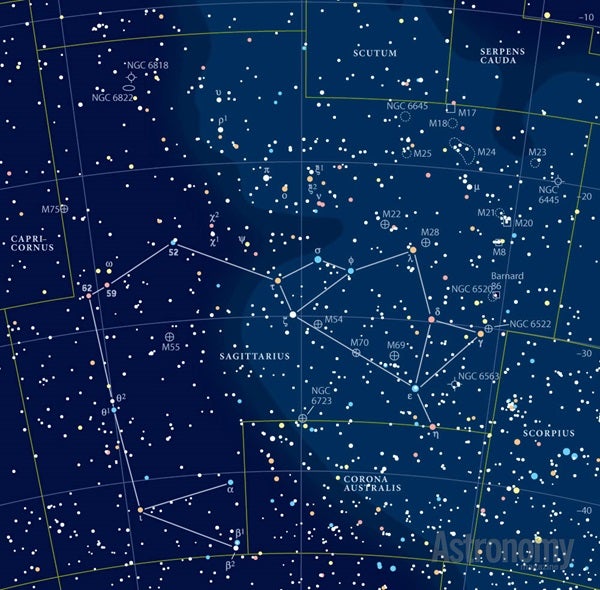Targets for September 10–17, 2015
Naked eye:
Scutum Star Cloud
Small telescope:
Wild Duck Cluster (M11)
Large telescope:
Barnard’s Galaxy (NGC 6822)
To find our first object, you won’t need any optical aid, but you will need to find the location of the small, faint constellation Scutum the Shield. Find the bright star Altair and its associated constellation Aquila. Scutum lies just off Aquila’s tail.
Under a dark, clear sky, you’ll notice this region of the summer Milky Way looks like it contains more stars than nearby areas. We call such spots star clouds, and, indeed, lots of star formation is happening here.
Once you can find Scutum easily, view it through binoculars. Now that’s a lot of stars!
Smyth’s duck
Our second object looks great not only through binoculars, but also in small telescopes. It’s the Wild Duck Cluster, also known as M11. Nineteenth-century astronomer William Henry Smyth described this cluster as looking like a flock of wild ducks or geese in flight. It’s been known as the Wild Duck ever since.
Sharp-eyed observers can spot M11 with their unaided eyes about 3° west-southwest of the two stars that form Aquila’s tail. You probably spotted it through binoculars while scanning the Scutum Star Cloud. Even a 3-inch telescope reveals several dozen stars in M11.
Bright, but also faint
If you use an 8-inch or larger telescope, insert the eyepiece that gives you the widest field of view, and look for Barnard’s Galaxy, also known as NGC 6822. This object lies in Sagittarius 1.5° north-northeast of 5th-magnitude 55 Sagittarii.
Barnard’s Galaxy shines at magnitude 9.3 — pretty bright for a galaxy. Unfortunately, its light is spread out over an area 16′ by 14′, so its overall surface brightness is low.
Look for a dim haze roughly twice as long as it is wide. Note the slightly brighter streak that spans NGC 6822’s long axis.
Larger scopes show several star-forming regions along the galaxy’s northern end. To see just these, use a nebula filter. Without a filter, and through a 12-inch or larger scope, look for individual supergiant stars. They’re faint — the brightest glow at only 14th magnitude — but they reveal themselves by lending a granular appearance to the galaxy.
Expand your observing at Astronomy.com
StarDome
Check out Astronomy.com’s interactive StarDome to see an accurate map of your sky. This tool will help you locate this week’s targets.
The Sky this Week
Get a daily digest of celestial events coming soon to a sky near you.
Observing Basics
Find more guidance from Senior Editor Michael E. Bakich with his Observing Basics video series.











